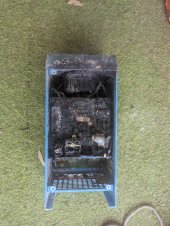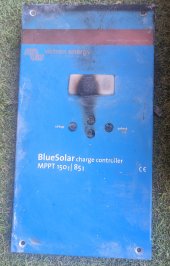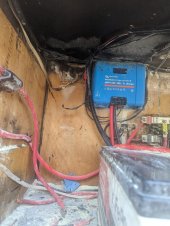You have to set the victron mppt to a gel/AGM appropriate mode
Cool. I've got that because I already had AGM prior to these. Anything else? It doesn't need something to say, "hey these are new batteries, not the old ones"?
You have to set the victron mppt to a gel/AGM appropriate mode
Cool. I've got that because I already had AGM prior to these. Anything else? It doesn't need something to say, "hey these are new batteries, not the old ones"?
Update:
We decided, due to lack of time (moving into the bus tomorrow morning and need to leave our house), that we are going to skip having an inverter/charger for now until I have more time to get Victron set up. We replaced our batteries with new AGM batteries (ugh. I so was hoping to have lithium be my next upgrade, but don't have the budget at the moment).
Question: I have a Victron MPPT and Victron BMV-700 battery monitor. Do I need to do anything specific to tell these two that these are new batteries? Or is it basically just plug and play? I'd read through the manual, but since we're moving in the morning, I'm a bit slammed at the moment.
You have to set the victron mppt to a gel/AGM appropriate mode
If you link the battery specifications, I can give you the correct settings for both devices.
Nominal Voltage | 20Hr Capacity | RC (min) | Energy (kWH) | Terminal Posts | Dimensions | Weight | Charging Current* | Charging Voltage | Float Voltage |
12V | 125AH | 260 | 1.700 | 8mm (M8*1.25) | 12.9"w x 6.8"d x 8.5"h(8.7"th**) | 75lb | 8A-35A | 14.4-14.9V | 13.5V-13.8V |
I just looked all over my MPPT, and I don't see any input for a temperature gauge. Where does that plug in? Does it go in the same place where the USB adapter connects? That's the only open slot I see. I have the 100|50 MPPT.
Not even Victron are absolutely safe. I have two 150/85 mppt's, two Multiplus 3000/12/150-20 Inverters a Lynxx Distributor all wired & fused correctly. Two weeks ago, smelt burning, ran outside smoke pouring from solar cabinet in our bus. Got the fire out, and found one of the MPPT had self ignited. Supplier sent me a brand new one, no questions. Victron flicked my email seeking answers straight back to the supplier. They weren't interested in even communicating with me.Sorry to hear of your loss. Glad to hear no fire was started.
Long story short, I started with a full Renogy setup and have since replaced every piece except for a couple of solar panels.
I wasted so much time, energy and money trying to get Renogy things to work right. Cheap price+poor design = expensive lessons.
Replace with Victron and you’ll have no regrets. The Multiplus line is exactly that, shore charger plus solar charge controller. Or it’s cheaper to go individual units and add your own switch.


 a Blazecut fire suppression system just in case.
a Blazecut fire suppression system just in case.Took me days to clean out the dry powder, replace damaged wiring and check and clean all the rest of the Equipment too. LolNot even Victron are absolutely safe. I have two 150/85 mppt's, two Multiplus 3000/12/150-20 Inverters a Lynxx Distributor all wired & fused correctly. Two weeks ago, smelt burning, ran outside smoke pouring from solar cabinet in our bus. Got the fire out, and found one of the MPPT had self ignited. Supplier sent me a brand new one, no questions. Victron flicked my email seeking answers straight back to the supplier. They weren't interested in even communicating with me.
I am now installing View attachment 182568View attachment 182567View attachment 182566a Blazecut fire suppression system just in case.
How lucky were we, not to have been asleep and now dead! New motto.... Plan for disaster, prepare for it no matter the cost.
Not even Victron are absolutely safe. I have two 150/85 mppt's, two Multiplus 3000/12/150-20 Inverters a Lynxx Distributor all wired & fused correctly. Two weeks ago, smelt burning, ran outside smoke pouring from solar cabinet in our bus. Got the fire out, and found one of the MPPT had self ignited. Supplier sent me a brand new one, no questions. Victron flicked my email seeking answers straight back to the supplier. They weren't interested in even communicating with me.
I am now installing View attachment 182568View attachment 182567View attachment 182566a Blazecut fire suppression system just in case.
How lucky were we, not to have been asleep and now dead! New motto.... Plan for disaster, prepare for it no matter the cost.
Any idea what caused it was the MPPT voltage close to the max rating? I read some threads here even getting close to the max voltage can fry things. I assumed there was protection in these things would shut down, but I guess not.Took me days to clean out the dry powder, replace damaged wiring and check and clean all the rest of the Equipment too. Lol
Nope there is not protection against too high voltage in most charge controllers.Any idea what caused it was the MPPT voltage close to the max rating? I read some threads here even getting close to the max voltage can fry things. I assumed there was protection in these things would shut down, but I guess not.
I noticed that you don't mention what type of controllers. If they were also Renogy then maybe I need to point out that Renogy specifically says that the only controllers they have that run in parallel are their 100 amp controllers. All others will miscommunicate and either not charge or overcharge batteries. I became aware of this when I ran two of their 40 amp rover MPPT controllers in parallel and toasted 3 255 amp hour AGM's. and I agree with everybody who said money spent on Renogy is wasted money. Eventually, you will have to replace the equipment with something of quality.Likely because it has no idea the batteries were at 100% since there's no communication between the devices, and it was charging based on its own criteria.
Your AGM have almost certainly sustained damage in the form of electrolyte loss, reduced capacity and increased internal resistance. I wouldn't write them off, but the outlook isn't good.
If you do not have AC connected to the input of the inverter, it can't charge.
probably
Probably, but that may not be its fault.
The likely explanation is that the inverter/charger wasn't configured properly.
A link to the charger manual would be very helpful.
I noticed that you don't mention what type of controllers.
If they were also Renogy then maybe I need to point out that Renogy specifically says that the only controllers they have that run in parallel are their 100 amp controllers.
All others will miscommunicate and either not charge or overcharge batteries. I became aware of this when I ran two of their 40 amp rover MPPT controllers in parallel and toasted 3 255 amp hour AGM's. and I agree with everybody who said money spent on Renogy is wasted money. Eventually, you will have to replace the equipment with something of quality.

Supplier said it was too damaged to be sure as to cause, other than agreeing with me, it started about half way up the unit, definitely not at the cabling inputs.Oh wow, that sucks! AFAIK, Victron won't communicate directly with consumers, they only will talk with the dealers. It comes across to some of us as rude or uncaring, but that is just their business model. So what did the seller/dealer say as to what they think the cause was? Or did you have the fire department inspect it and see if they could tell what caused it to ignite? A fly or moth in the wrong place (or mouse) has been known to cause fires like this.


